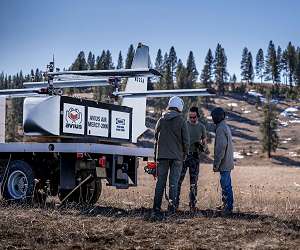Initially earmarked for covert military operations, unmanned aerial vehicles (UAVs) or drones have since gained tremendous popularity, which has broadened the scope of their use. In fact, “remote pilot” drones have been largely replaced by “autonomous” drones for applications in various fields. One such application is their usage in rescue missions following a natural or man-made disaster. However, this often requires the drones to be able to land safely on uneven terrain–which can be very difficult to execute.
“While it is desirable to automate the landing using a depth camera that can gauge terrain unevenness and find suitable landing spots, a framework serving as a useful base needs to be developed first,” observes Dr. Chinthaka Premachandra from Shibaura Institute of Technology (SIT), Japan, whose research group studies potential applications of camera-based quadrocopter drones.
Accordingly, Dr. Premachandra and his team set out to design an automatic landing system; they have detailed their approach in their latest study published in IEEE Access. To keep things simple, they upgraded a standard radio control (RC)-based drone with necessary hardware and software and equipped it with a simple 2D camera for the detection of a symbolized landing pad.
“The challenges in our project were two-fold. On the one hand, we needed a robust and cost-effective image-processing algorithm to provide position feedback to the controller. On the other, we required a fail-safe switch logic that would allow the pilot to abort the autonomous mode whenever required, preventing accidents during tests,” explains Dr. Premachandra.
Eventually, the team came up with a design that comprised the following components: a commercial flight controller (for attitude control), a Raspberry Pi 3B+ (for autonomous position control), a wide-angle modified Raspberry Pi v1.3 camera (for horizontal feedback), a servo gimbal (for camera usage control), a Time-of-Flight (ToF) module (as feedback sensor for the drone height), a multiplexer (for switching between manual and auto modes), an “anti-windup” PID controller (for height control), and two PD controllers (for horizontal movement control).
In addition, they implemented an image-processing algorithm that detected a distinctive landing symbol (in the shape of “H”) in real time and converted the image pixels into physical coordinates, which generated a horizontal feedback. Interestingly, they found that introducing an adaptive “region of interest” helped speed up the computation of the camera’s vertical distance to the landing symbol, greatly reducing the computing time–from 12-14 milliseconds to a meagre 3 milliseconds!
Following detection, the system accomplished the landing process in two steps: flying towards the landing spot and hovering over it while maintaining the height, and then actually landing vertically. Both these steps were automated and therefore controlled by the Raspberry Pi module.
While examining the landing, the research team noticed a disturbance in landing behavior, which they attributed to an aerodynamic lift acting on the quadrocopter. However, this problem could be overcome by boosting the gain of the PID controller. In general, performance during the landing process indicated a properly functioning autonomous system.
With these results, Dr. Premachandra and his team look forward to upgrading their system with a depth camera and thus enabling drones to find even more applications pertaining to daily life. “Our study was primarily motivated by the application of drones in rescue missions–But it shows that drones can, in future, find use in indoor operations such as indoor transportation and inspection, which can reduce a lot of manual labor,” concludes Prof. Premachandra.
Research Report: Development of an Automated Camera-Based Drone Landing System
Related Links
Shibaura Institute Of Technology
UAV News – Suppliers and Technology
|
We need your help. The SpaceDaily news network continues to grow but revenues have never been harder to maintain. With the rise of Ad Blockers, and Facebook – our traditional revenue sources via quality network advertising continues to decline. And unlike so many other news sites, we don’t have a paywall – with those annoying usernames and passwords. Our news coverage takes time and effort to publish 365 days a year. If you find our news sites informative and useful then please consider becoming a regular supporter or for now make a one off contribution. |
||
|
SpaceDaily Contributor $5 Billed Once credit card or paypal |
SpaceDaily Monthly Supporter $5 Billed Monthly paypal only |
|

![]()
Commercial 1-ton cargo delivery glider to be scaled down for expanded military operations
Los Angeles CA (SPX) Feb 17, 2021
Silent Arrow reports that the US Air Force has awarded contract FA864921P0478 entitled “Feasibility of Downsizing and Adapting Commercial Silent Arrow Cargo Delivery UAS to Meet Specific AFSOC Operational Requirements” to the company effective February 5, 2021. The contract will be executed in partnership with the Air Force Research Laboratory (AFRL) with funding from AFWERX.
Under this Small Business Innovation Research (“SBIR”) contract, the commercially successful Silent Arrow GD-2000 (Glider, … read more
 Unmanned Aerial Vehicle The latest drone news
Unmanned Aerial Vehicle The latest drone news



